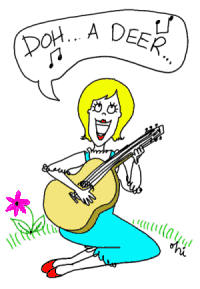 |
Regular Columnists |
 |
Major Scales (Part 1): Steps and half-steps
By Debbie Ridpath Ohi - 06/04/2007 - 11:06 AM EDT

In
the past months, we've discussed some of the fundamentals of music
theory, like basic time rhythms, names of the lines and spaces on
the treble and bass clef.
The
next topic we're going to discuss is the major scale. Knowing about
scales is massively useful for a songwriter. There are many different
types of scales, but the most commonly used scales are major scales
and minor scales.
Chances
are good that you already know what a major scale sounds like. Think
back to your grade school days, when your music teacher taught you
how to sing "doh - ray - me - fah - so - la - ti - doh"? That was
a major scale. Julie Andrews sang about the major scale in the Rogers
& Hammerstein movie, The Sound Of Music ("Doh, a deer, a female
deer....ray, a drop of golden sun...")

When
you sing "doh - ray - me - fah - so - la - ti - doh", you're singing
an ascending major scale. If you start at the top and sing
your way back down ("doh - ti - la - so - fah - me - ray - doh"),
you're singing a descending major scale. I know this is pretty
obvious, but I just want to make sure we're all familiar with the
basic terms.
Every
scale is composed of a specific patterns of whole steps and
half-steps. Sometimes these are referred to as tones
and semi-tones. One whole step is made up of two half-steps.
For
guitar players: Think of each line on the fretboard representing
a half-step. Try the following exercise...Pick a string, then place
your finger on the first fret. Play the string. Move your finger
up another fret (a half-step) and play the string again. Repeat
this process, moving up the fretboard.
Or
you could think of a piano keyboard:

Now
imagine that the bottom half has been cut off, so you're left with
just the top half of the keyboard:

Imagine
that you are playing each note starting from the one on the left,
then across until you hit the black note on the far right (i.e.
black, white, white, black, white, black, white, white, black).
Each note that you play is a half-step higher than the one before.

If
you have access to a piano, then you can try actually playing this.
Be sure to focus on the top half of the keyboard, else you may not
be playing half-steps. Example:

In
the example above, playing the C note followed by the D note is
a WHOLE step, not a half-step. Why? Because of the black note that
is between C and D.
On
a guitar, you can play a whole step by moving your finger up two
frets instead of just one.
Still
confused? Don't worry. For now, just remember that two half-steps
make a whole step.
NEXT
MONTH: We'll take a look at how steps and half-steps make up a major
scale.
[ Current Articles | Archives ]
|











